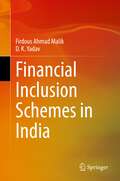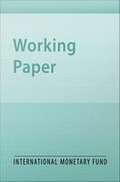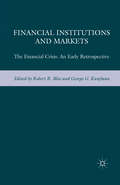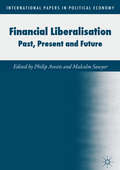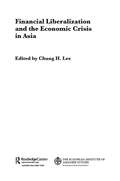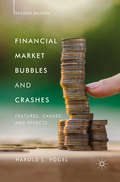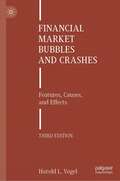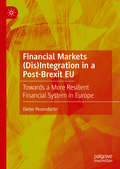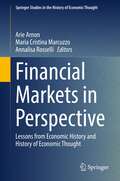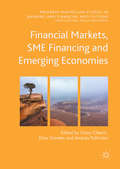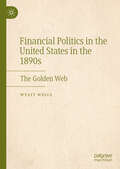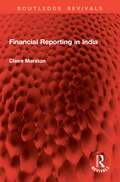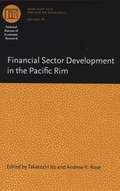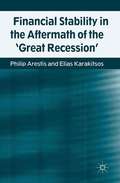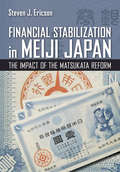- Table View
- List View
Financial Inclusion Schemes in India
by Firdous Ahmad Malik D. K. YadavThe exclusion of the destitute population from the formal financial system is a long-standing problem in India. This book examines the performance of financial inclusion policies in India to understand their impact on two urban vulnerable groups, Slum Dwellers and Beggars. This study includes analysis at the national level, the variables of the financial inclusion index like Penetration, Availability, and Usage from 2006 to 2020 from the world bank data set. Similarly, the authors examine five policies on financial inclusion by conducting a primary level survey on two urban capital cities of Lucknow and Kolkata, using a well-structured questionnaire for data collection. The authors uses two sampling techniques: simple random in the case of beggars, and stratified random in the case of slum dwellers.This book highlights the difference between financial access and non-access of household respondents in capturing the impacts of financial inclusion schemes on their socio-economic condition and financial behavior. The findings indicate that access to these schemes is extremely limited for the underprivileged population, such as beggars and slum dwellers. The analysis has shown that claims made by the government are not based on real-life occurrences. This book demonstrates that these programs have a negligible effect on life-deprived people.This book will be of interest to academia, policymakers, and society at large.
Financial Innovation, the Discovery of Risk, and the U.S. Credit Crisis
by Enrique G. Mendoza Emine BozA report from the International Monetary Fund.
Financial Institutions and Markets: The Financial Crisis: An Early Retrospective (Innovations In Financial Markets And Institutions Ser. #6)
by George G. Kaufman Robert R. BlissThis book is a collection of research papers that contribute to the understanding of ongoing developments in financial institutions and markets both in the United States and globally.
Financial Intermediation in a Less Developed Economy: The History of the United Bank of India
by Sugata Marjit Indrajit MallickFinancial Intermediation in a Less Developed Economy: The History of the United Bank of India is an institutional narrative of a bank in a developing economy, a representative case study that brings out the essential two-way relationship between finance and economic development. The book highlights that to understand financial intermediation, western theoretical models need to be complemented with institutional narratives of banking in developing economies, given the latter`s specific foci. Thus, the authors choose a bank with significant history in a less developed economy and analyze over 50 years of the bank`s balance sheet data. They trace the bank`s growth in terms of the transaction costs in managing risk, return and liquidity. The discourse also includes important case studies of borrowers after nationalization, a thorough analysis of financial intermediary organization and financial structure, reviews of certain banking policies and suggestion of a methodology to understand the financial history of less developed economies. This book will be of immense interest to policy makers, researchers and students working in the fields of economics of banking, financial history and development economics.
Financial Liberalisation
by Philip Arestis Malcolm SawyerThis book is the thirteenth volume in the International Papers in Political Economy (IPPE) series which explores the latest developments in political economy. A collection of eight papers, the book concentrates on the deregulation of domestic financial markets and discusses financial liberalisation in terms of its past performance, current progress and future developments. The chapters have been written by expert contributors in the field and focus on topics such as past records of financial liberalisation, future policies of regulation, and current account imbalances. Other papers examine capital account regulations in developing and emerging countries, and capital controls in the Eurozone after the 2007 financial crisis. This collection of papers invites readers to consider the impact of financial liberalisation both during and after the global economic crisis. Scholars and students with an interest in political economy, financialisation, and economic performance will find this collection stimulating and informative.
Financial Liberalization and Financial Fragility*
by Enrica Detragiache Ash Demirgüç-KuntA report from the International Monetary Fund.
Financial Liberalization and the Economic Crisis in Asia (European Institute of Japanese Studies East Asian Economics and Business Series)
by Chung H. LeeWhat brought about a financial crisis in the "miracle" economies of Asia? What went wrong with financial reform in Asia? What can the developing countries of the world learn from the reform experiences in Asia?Financial Liberalization and the Economic Crisis in Asia analyses how financial liberalization was undertaken in eight Asian countries and how it might be linked to the subsequent crises. The country studies focus on China, India, Indonesia, Japan, Malaysia, the Philippines, South Korea and Thailand.
Financial Market Bubbles and Crashes
by Harold L. VogelDespite the thousands of articles and the millions of times that the word 'bubble' has been used in the business press, there still does not appear to be a cohesive theory or persuasive empirical approach with which to study 'bubble' and 'crash' conditions. This book presents a plausible and accessible descriptive theory and empirical approach to the analysis of such financial market conditions. It advances such a framework through application of standard econometric methods to its central idea, which is that financial bubbles reflect urgent short side rationed demand. From this basic idea, an elasticity of variance concept is developed. It is further shown that a behavioral risk premium can probably be measured and related to the standard equity risk premium models in a way that is consistent with conventional theory.
Financial Market Bubbles and Crashes, Second Edition: Features, Causes, and Effects
by Harold L. VogelEconomists broadly define financial asset price bubbles as episodes in which prices rise with notable rapidity and depart from historically established asset valuation multiples and relationships. Financial economists have for decades attempted to study and interpret bubbles through the prisms of rational expectations, efficient markets, and equilibrium, arbitrage, and capital asset pricing models, but they have not made much if any progress toward a consistent and reliable theory that explains how and why bubbles (and crashes) evolve and can also be defined, measured, and compared. This book develops a new and different approach that is based on the central notion that bubbles and crashes reflect urgent short-side rationing, which means that, as such extreme conditions unfold, considerations of quantities owned or not owned begin to displace considerations of price.
Financial Market Bubbles and Crashes: Features, Causes, and Effects
by Harold L. VogelEconomists broadly define financial asset price bubbles as episodes in which prices rise with notable rapidity and depart from historically established asset valuation multiples and relationships. Financial economists have for decades attempted to study and interpret bubbles through the prisms of rational expectations, efficient markets, equilibrium, arbitrage, and capital asset pricing models, but they have not made much if any progress toward a consistent and reliable theory that explains how and why bubbles (and crashes) evolve and are defined, measured, and compared. This book develops a new and different approach that is based on the central notion that bubbles and crashes reflect urgent short-side rationing, which means that, as such extreme conditions unfold, considerations of quantities owned or not owned begin to displace considerations of price.
Financial Markets (Dis)Integration in a Post-Brexit EU: Towards a More Resilient Financial System in Europe
by Dieter PesendorferThe European Union is creating a Financial Union with a European Banking Union and a Capital Markets Union in reaction to lessons learned from incomplete financial markets integration, the Global Financial Crisis and European Sovereign Debt Crisis. This book critically analyses these projects for a more integrated, resilient and sustainable financial system at a time when the United Kingdom as the member state with the most developed capital markets and the leading global and European financial center, the City of London, is leaving the Union. Neoliberal financial globalization and markets integration policies have led to finance-led capitalism that caused the crises. By building on pre-crises integration ideas, the Union revives and expands the reach of capital markets-based financing and shadow banking. The book discusses the consequences of deeper integration and the future of European financial centers advocating an alternative financial markets integration based on theories explaining finacialization and finance-led capitalism.
Financial Markets and Foreign Direct Investment in Greater China
by Hung-Gay Fung Yahong ZhangBased on rigorous state-of-the-art research techniques, this book deals with critical issues regarding China's financial markets and foreign direct investment -- key components of China's economic transformation.
Financial Markets in Perspective: Lessons from Economic History and History of Economic Thought (Springer Studies in the History of Economic Thought)
by Arie Arnon Maria Cristina Marcuzzo Annalisa RosselliThis book examines financial markets from a historical perspective. Bringing together contributions from leading historians of economic thought, economists and economic historians, it offers an integrated approach and reflects on the workings of financial markets, their impact on and relation with the rest of the economy and how their role was and is understood by economics. The contributions cover topics such as classical and modern economic thinking on financial markets and institutions, as well as financial models and innovations, and also present case studies on financial history and on policy issues. The historical perspective leads to a representation of markets not as abstract and timeless mechanisms but as institutions populated by a diversity of agents, subject to rules and customs, and influenced by scientific developments and economic theories.
Financial Markets, SME Financing and Emerging Economies
by Giusy Chesini Elisa Giaretta Andrea PaltrinieriThis book investigates small and medium sized enterprises (SMEs) access to credit, the earning quality, and the cost of debt in the European Union. It also examines two important risk measures in financial markets: the volatility index (VIX) and Credit Default Swaps (CDS). Finally, it deep dives inside one of the most important emerging markets, China, to assess monetary policy and the relationship between financial institutions and real estate firms. This work will appeal to both academics and practitioners in the areas of SME financing, financial markets and emerging economies.
Financial Politics in the United States in the 1890s: The Golden Web
by Wyatt WellsIn the 1890s, the choice between the gold standard and the free coinage of silver upended American politics. The gold standard linked the United States to the larger international financial system, in which gold was the common denominator. The free coinage of silver would effectively sever these ties by devaluing the dollar. The gold standard allowed the U.S. to secure vast amounts of foreign capital on good terms to build railroads and develop industry, but at the cost of deflation. The free coinage of silver would raise prices, particularly for cotton and wheat, whose cultivators carried heavy debts and were hard-pressed. The struggle would define the United States. Would it continue to develop industrially, or would it return to its agricultural roots? The combatants—among them Grover Cleveland, William Jennings Bryan, J.P. Morgan, and William McKinley—understood what was at stake. This book deals both with well-known aspects of the contest, such as the 1896 Presidential election between McKinley and Bryan, and lesser-known ones, such as how the currency issues interacted with racial politics and international negotiations over the role of silver in the world&’s monetary system. The result is the most comprehensive account of financial politics in the United States in the 1890s yet published.
Financial Regulation
by Faia, Ester and Hackethal, Andreas and Haliassos, Michael and Langenbucher, Katja Ester Faia Andreas Hackethal Michael Haliassos Katja LangenbucherThe 2007 to 2009 financial crisis resulted in the re-emergence of the debate on financial regulation and its relationships with other macroeconomic policies, particularly monetary policy. In Europe, the financial crisis was followed by the sovereign debt crisis, as the bail-out of the financial sector put strains on public finances in several countries. The sequence of events called for a strengthening of the union, ranging from a common framework for supervisory policy that could minimize the risk of unforeseen bank or country defaults to a common resolution mechanism that could set equal rules across countries and reduce ex-ante mis-incentives to risk-taking and moral hazard. This analysis of the state of and prospects for financial regulation examines the lending and saving behavior of banks and households as well as their borrowing activities in order to understand the conflicting priorities and complicated decisions involved in the development and implementation of financial legislation.
Financial Reporting in India (Routledge Revivals)
by Claire MarstonFirst published in 1986, Financial Reporting in India provides a comprehensive review of Indian financial reporting and makes a comparison with the United Kingdom. The book compares and contrasts financial reporting practices in the United Kingdom and India by examining the influences on accounting practices in the two countries and by comparing the actual accounting practices and level of disclosure of information in financial reports. It concludes by providing information on the amount of influence exerted by the United Kingdom on Indian accounting practices. This book will be of interest to students and researchers of Asian studies and economics.
Financial Sector Crisis and Restructuring Lessons from Asia
by Charles Enoch Carl Johan Lindgren Leslie TeoA report from the International Monetary Fund.
Financial Sector Development in the Pacific Rim
by Takatoshi Ito Andrew RoseThe reform in Asian financial sectors-- especially in banking and stock markets-- has been remarkable since the currency crisis of 1997-98. East Asia is now a major player in international finance, providing serious competition to the more traditional financial centers of London and New York. Financial Sector Development in the Pacific Rim provides a rich collection of theoretical and empirical analyses of the growing capital markets in the region. Bringing together authors from various East Asian and Pacific nations, this volume examines the institutional factors influencing financial innovation, the consequences of financial development, widespread consolidation occurring through mergers and acquisitions, and the implementation of policy reform. Financial Sector Development in the Pacific Rim offers the comparative analysis necessary to answer broad questions about economic development and the future of Asia.
Financial Shocks and TFP Growth
by Marcello Estevão Tiago SeveroA report from the International Monetary Fund.
Financial Speculation and Fictitious Profits: A Marxist Analysis (Marx, Engels, and Marxisms)
by Gustavo Moura de Cavalcanti Mello Mauricio de Souza SabadiniThis book provides an original account of financialisation and outlines the creation of fictitious profits as a basis to describe the present phase of capitalist accumulation in the neoliberal era. Making innovative theoretical elaborations on Marx’s notion of fictitious capital, Financial Speculation and Fictitious Profits offers a dialectic analysis of the increasing financialization during this crisis-ridden period based on the original concepts of fictitious profit and fictitious wealth. Combining the most important research from over twenty years of scholarly inquiry with groundbreaking new studies, Financial Speculation and Fictitious Profits is more than a collection of texts by political economists on a contemporary topic; it is a synthesis of an intense process of academic production that began with work of Karl Marx and has resulted in the formulation of a differentiated interpretative perspective on the contemporary evolution of capitalist crisis.
Financial Spillovers to Emerging Markets During the Global Financial Crisis
by Nathaniel Frank Heiko HesseA report from the International Monetary Fund.
Financial Stability in the Aftermath of the �Great Recession�
by Philip Arestis Elias KarakitsosThe financial crisis and the ensued 'great recession' are primarily caused by the excessive liquidity that was created in the last thirty years or so of inequality that benefited greatly the financial sector, deregulation and financial liberalisation as well as financial innovation.
Financial Stabilization in Meiji Japan: The Impact of the Matsukata Reform (Cornell Studies in Money)
by Steven J. EricsonWith a new look at the 1880s financial reforms in Japan, Steven J. Ericson's Financial Stabilization in Meiji Japan overturns widely held views of the program carried out by Finance Minister Matsukata Masayoshi. As Ericson shows, rather than constituting an orthodox financial-stabilization program—a sort of precursor of the "neoliberal" reforms promoted by the IMF in the 1980s and 1990s—Matsukata's policies differed in significant ways from both classical economic liberalism and neoliberal orthodoxy.The Matsukata financial reform has become famous largely for the wrong reasons, and Ericson sets the record straight. He shows that Matsukata intended to pursue fiscal retrenchment and budget-balancing when he became finance minister in late 1881. Various exigencies, including foreign military crises and a worsening domestic depression, compelled him instead to increase spending by running deficits and floating public bonds. Though he drastically reduced the money supply, he combined the positive and contractionary policies of his immediate predecessors to pull off a program of "expansionary austerity" paralleling state responses to financial crisis elsewhere in the world both then and now.Through a new and much-needed recalibration of this pivotal financial reform, Financial Stabilization in Meiji Japan demonstrates that, in several ways, ranging from state-led export promotion to the creation of a government-controlled central bank, Matsukata advanced policies that were more in line with a nationalist, developmentalist approach than with a liberal economic one. Ericson shows that Matsukata Masayoshi was far from a rigid adherent of classical economic liberalism.
Financial Statecraft: The Role of Financial Markets in American Foreign Policy
by Benn Steil Robert E. LitanAs trade flows expanded and trade agreements proliferated after World War II, governments--most notably the United States--came increasingly to use their power over imports and exports to influence the behavior of other countries. But trade is not the only way in which nations interact economically. Over the past two decades, another form of economic exchange has risen to a level of vastly greater significance and political concern: the purchase and sale of financial assets across borders. Nearly $2 trillion worth of currency now moves cross-border every day, roughly 90 percent of which is accounted for by financial flows unrelated to trade in goods and services--a stunning inversion of the figures in 1970. The time is ripe to ask fundamental questions about what Benn Steil and Robert Litan have coined as "financial statecraft," or those aspects of economic statecraft directed at influencing international capital flows. How precisely has the American government practiced financial statecraft? How effective have these efforts been? And how can they be made more effective? The authors provide penetrating and incisive answers in this timely and stimulating book.
